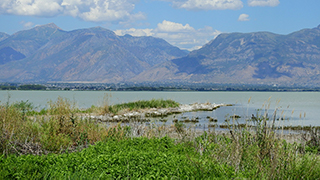The goal of the Utah Lake Water Quality Study (ULWQS) is to develop nitrogen and phosphorus criteria that are protective of the lake’s designated beneficial uses. The study approach consists of three phases to achieve this goal:
- Phase 1 – Data gathering and characterization
- Phase 2 – Development of in-lake criteria for nitrogen and phosphorus
- Phase 3 – Implementation planning for Phase 2 criteria

Utah Lake is one of the largest natural freshwater lakes in the western United States. The lake is considered hypereutrophic, meaning it is overly rich in nutrients such as nitrogen and phosphorous. Excessive concentrations of nutrients cause large seasonal algal blooms, elevated pH, and possible cyanotoxin production during harmful algal blooms. The lake is the receiving body for wastewater treatment plant effluent, industrial discharges, stormwater discharges, and nonpoint source runoff. Rapid growth and urban expansion within the watershed may be exacerbating these hypereutrophic conditions.





